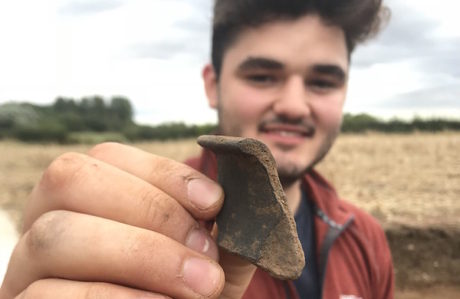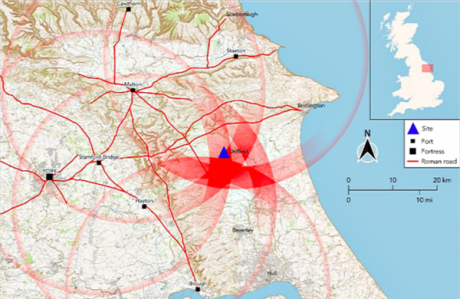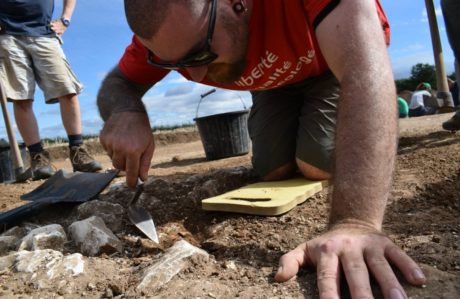
We had just one week to investigate the site of a suspected Roman villa. Did we find it?
It has been a fantastic week of excavation out here in East Yorkshire, and we want to say a great big THANK YOU to all you lovely Venturers who have supported the dig. You can see everyone who took part on the Dig Team page.
Our investigation follows on from what we found in 2018, when we were investigating another area of the site that contained the remains of a Late Iron Age settlement that expanded during the early Roman period. This year, our aim was to investigate a new area where we suspected there might be a Roman villa, or other high-status Roman homestead that may have been established a century or so later. Here’s a summary of what we managed to uncover…
Trench 7 (Josh’s trench, aka the over-flowing-with-archaeology trench)
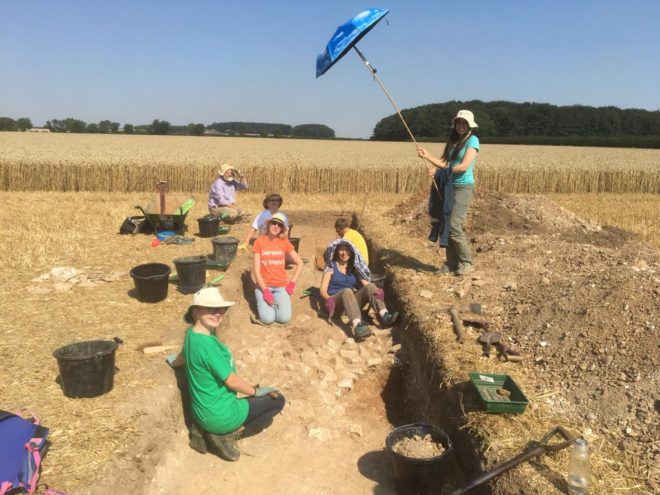
In Trench 7, the Venturers revealed six pits, one ditch, and a large cobble spread, which may represent a floor or collapsed wall. The archaeology was covered by a chalky spread which is where most of the finds came from, including ceramic roof tiles, floor tiles, hypocaust tile, stone roof tiles and possible flagstones, plenty of mosaic tesserae, a bone hairpin and a tibia and fibula, possibly of a dog.
Four of the pits cut through the cobble spread, which seems to overlie the ditch, while one of the larger pits was cut into a smaller pit filled with ashy/charcoal rich sediment and contained a sherd of prehistoric pottery with burnt residue on the inside. Together, this suggests we’ve got at least three phases of archaeological activity: prehistoric, Roman, and post-Roman, and will eventually help us put together a larger chronology of the site.
Trench 8 (Indie’s trench, aka the chalky trench)

In Trench 8, the Venturers found five post-holes, and two ditches. The archaeology was covered by a chalky spread which is where most of the finds came from, including some Roman roof tiles. One of the post-holes was cut into this spread, so we can tell that there were at least two phases of activity in this area.
Trench 9 (Maggie’s trench, aka the DigCamp trench)
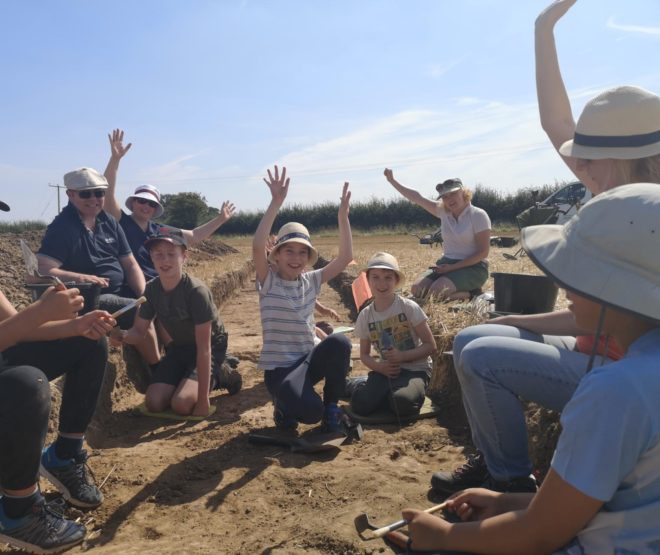
Trench 9 was excavated early in the week and, of all the trenches, seemed to contain the least archaeology – at first. However, that all changed when DigCamp arrived on Saturday, and our Junior Archaeologists identified a post-hole that the grown-ups hadn’t seen. In fact, it made the team wonder whether we had in fact gone deep enough, and whether there might actually be more archaeology further down. Some shallow ditches and pits gradually emerged, and the team also found a Mesolithic flint. It’s possible that there’s more to this trench than first met the eye, and that it would require further excavation to find out…
Trench 10 (Harriet’s trench, aka the massive post-hole trench)

In Trench 10, the Venturers unearthed four post holes, two of which seemed to go on forever – our longest-armed Venturer couldn’t reach the bottom, indicating that they were at least shoulder deep.
As a general rule of thumb, post-holes will be around 1/4 or 1/3 of the post they hold. These ones are certainly big enough to hold upright timbers that could have supported a roof, and hint at a possible aisled building. One had a fragment of Samian ware at the bottom, while the other was packed with oyster shells (which the Romans loved to eat), along with some animal bone, providing additional evidence that these post-holes were made in or around the Roman period.
The Venturers also unearthed a ditch with several different fills, and found plenty of Roman grey ware in the most recent layer. Many of the pieces were large, and unworn, suggesting they hadn’t moved far from their original location!
So have we found a Roman villa?

Now that we’ve exposed all the archaeology, and got the features and stratigraphy recorded, do we think we’ve found a Roman villa? When a building gets ruined, the remains get spread out and in the words of our Head of Fieldwork Chris, what we’ve uncovered is a ‘settlement splurge’.
It seems that a large amount of the chalky limestone blocks and other building materials were later robbed out and recycled for use in other buildings, but there’s certainly enough evidence to say that once upon a time, there was almost certainly a high-status Roman building here, with a mosaic floor, central heating and, judging by the post-holes, possibly also a Roman aisled building.
In 2018, we unearthed the remains of a Late Iron Age settlement, which expanded when the first Romans crossed the Humber around AD 71 and throughout the early Roman period. Judging by the pottery, it may have been a trading or staging post and grew large enough to support a substantial market economy.
Our discoveries from this year’s dig in 2019 suggest that this growth made the surrounding area attractive enough that someone eventually decided to settle here. We’ve got all the key ingredients of a high-status Roman homestead – a displaced mosaic floor, a hypocaust (heating) system, and plenty of fancy pottery. Whether all these pieces fit together to form a Roman villa is something we’ll figure out in the post-excavation phase of our research, but it certainly seems possible.
What’s more, it’s one that has previously been recorded, which means it’s an entirely new addition to the story of the Romans in East Yorkshire. What we’ve uncovered seems to represent the next chapter in the story of the Romans of East Yorkshire, a few generations on from those who first crossed the Humber.
What next?
We’ll be sending all of the artefacts we found off for specialist analysis, and will soon be posting a video with some of our highlights from the dig. As soon as we get some results, we’ll be back in touch to share the news.
Most importantly, our gut feeling is that the evidence we’ve collected over the last two years is robust enough to warrant further investigation and another season of excavation in 2020… we hope you’ll join us!
